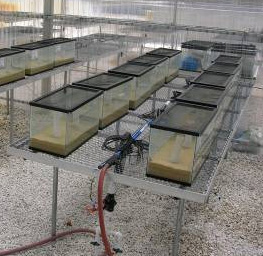Sniff'n'StopTM Frog Deterrent Testing
Cuban Treefrog
The Cuban Treefrog (Osteopilus septentrionalis) can cause power outages by short-circuiting switches on power poles -- outages that cost the power companies money, time, and resources. Cuban Treefrogs hiding in switch boxes or transformers can bridge gaps, causing short circuits and power outages that can be difficult to diagnose. We tested the effectiveness of an animal deterrent product called Sniff'n'Stop (www.sniffnstop.com) for preventing Cuban Treefrogs from using a PVC pipe as a refuge -- frogs were given a choice between a PVC pipe with deterrent and one without. This product has proven useful with a variety of other wildlife species, and we found that it is also an effective Cuban Treefrog repellent. The results of this study were published in the journal Human-Wildlife Conflicts.
Johnson, S.A., M.E. McGarrity and C.L. Staudhammer. 2010. An effective chemical deterrent for invasive Cuban treefrogs (Osteopilus septentrionalis) (3.51MB pdf). Human-Wildlife Interactions 4:112-117.
Puerto Rican Coqui Frog
Puerto Rican Coquis (Eleutherodactylus coqui) have been introduced in Hawaii and are considered invasive. Their unbearably loud breeding calls drive property values down, reduce tourist appeal, and affect residents' quality of life. The government goes to great expense to ensure that these frogs are not transported to other islands in the archipelago as hitchhikers on plants. We tested the effectiveness of a new granular formulation of Sniff'n'Stop for keeping invasive coquis from hiding in ornamental plants. Preliminary testing showed that this deterrent was highly effective for use with coquis; however, we have not yet been able to secure funding to continue with this research.


